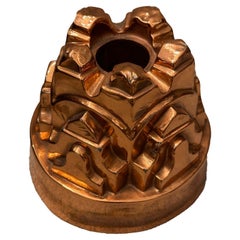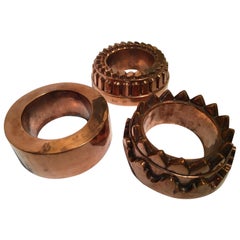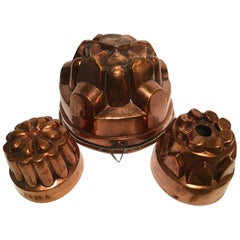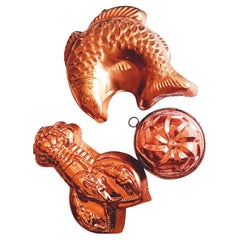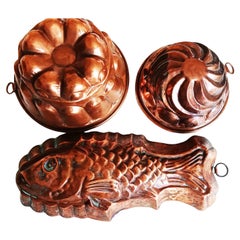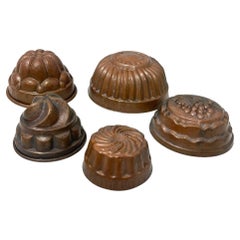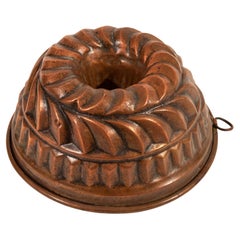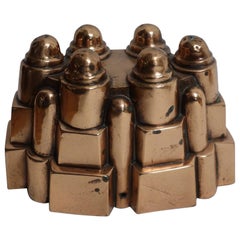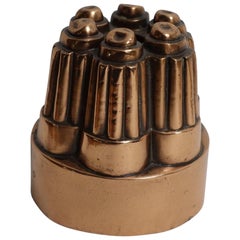Copper Pudding Mold
Victorian copper pudding mold by W.S. Adams & Son
Located in Paris, FR
A fine late 19th-century antique English Victorian copper pudding mold with a rich patina, the body
Category
20th Century English Victorian Decorative Art
Materials
Copper
France Late 18th Century Set 3 Kitchen Copper Pudding Molds for Wall Decoration
Located in Brescia, IT
These pudding molds are a set composed by three nice France pieces fine hand made in copper. One of
Category
Antique Late 18th Century French Rustic Decorative Bowls
Materials
Copper
$2,155 / set
H 2.96 in Dm 7.88 in
France Late 18th Century Set 3 Kitchen Copper Pudding Molds for Wall Decoration
Located in Brescia, IT
These pudding molds are a set composed by three nice France pieces fine hand made in copper. All of
Category
Antique Late 18th Century French Rustic Decorative Bowls
Materials
Copper
$2,155 / set
H 4.53 in Dm 6.89 in
Cooper Molds for Kitchen Fish and Lobster Wall Decoración Lot 3
Located in Mombuey, Zamora
Provence.; Copper fish mold. Copper rooster mold. Copper pudding mold. Copper lobster mold. Antique round
Category
Early 20th Century Italian Country Decorative Art
Materials
Copper
$651 Sale Price / set
44% Off
H 8.67 in W 6.7 in D 1.58 in
Antique Cooper Molds Fish an Round Forms Kitchen Wall Decoración Lot 3
Located in Mombuey, Zamora
Provence.; Copper fish mold. Copper rooster mold. Copper pudding mold. Copper lobster mold. Antique round
Category
Early 20th Century Spanish Country Decorative Art
Materials
Copper
$592 Sale Price / set
50% Off
H 8.67 in W 6.7 in D 1.58 in
Dutch copper pudding bakeware, molds
Located in Delft, NL
Dutch copper pudding bakeware, molds
Early 20th Century, ca 1900-1910 five pieces of Dutch baking
Category
Early 20th Century Dutch Tableware
Materials
Copper
Copper Pudding
Located in Alessandria, Piemonte
Old copper pudding or cake mold : now for decoration in the dining or kitchen wall.
ref. O/7445
Category
Mid-20th Century Italian Arts and Crafts Serving Pieces
Materials
Copper
Recent Sales
Copper Pudding Mold, French, 19th Century
Located in San Francisco, CA
19th century French solid copper pudding mold, tin lined with beautiful patina and in fine
Category
Antique 19th Century French Decorative Art
Materials
Copper
Copper Pudding Mold, French 19th Century
Located in San Francisco, CA
This 19th century French solid copper pudding mold is tin lined, having beautiful patina and in
Category
Antique 19th Century French Decorative Art
Materials
Copper
Copper Pudding Mold, French, 19th Century
Located in San Francisco, CA
This late 19th century French solid copper pudding mold is tin lined and is in fine shape with a
Category
Antique Late 19th Century French Decorative Art
Materials
Copper
Antique Copper Pudding Mold, French, 19th Century
Located in San Francisco, CA
A 19th century French solid copper pudding mold, tin lined and in fine condition.
Category
Antique 19th Century French Decorative Art
Materials
Copper
Antique Copper Pudding Mold, French, 19th Century
Located in San Francisco, CA
A 19th century French solid copper pudding mold, tin lined and with beautiful patina, in fine
Category
Antique 19th Century French Decorative Art
Materials
Copper
France Late 18th Century Set 3 Kitchen Copper Pudding Molds for Wall Decoration
Located in Brescia, IT
These pudding molds are a set composed by three nice France pieces fine hand made in copper. One of
Category
Antique Late 18th Century French Rustic Decorative Bowls
Materials
Copper
Hammered Copper Victorian English Pudding Molds, Sun and Waves, Set of Two
Located in Philadelphia, PA
A pair of large English pudding molds, made of hammered copper and lined in tin, circa 1890-1910. A
Category
Antique Late 19th Century English Victorian Platters and Serveware
Materials
Copper, Tin
19th Century Victorian English Copper Tin Lined Pudding, Aspic, Jelly Molds, S/3
Located in Philadelphia, PA
, Victorian English copper, tin-lined, pudding, aspic or jelly molds. Hand-hammered and heavy, the forms
Category
Antique Mid-19th Century English High Victorian More Dining and Entertai...
Materials
Copper, Tin
H 4 in W 4 in D 6 in
Rare Lion Design Antique Copper Mold
Located in London, GB
Rare lion design antique copper mold
This is a are lion design copper pudding mold
English or
Category
Antique Mid-19th Century British More Folk Art
Materials
Copper
Trio of Antique French and Dutch Copper Cake Molds or Jelly Molds, c. 1910
Located in San Francisco, CA
A charming set of three circa 1910 architectural and whimsical copper cake, jelly, or pudding
Category
Vintage 1910s European Art Deco Serving Pieces
Materials
Copper
People Also Browsed
Oil on Canvas "Bullfighting" by Jose Gonzalez De La Pena (1887-1961)
Located in Lambertville, NJ
Early 20th Century oil painting on canvas titled "Bullfighting" by Jose Gonzalez De La Pena. Framed measurement 40 wide by 34 high, in original gilt and ebonized frame.
José de l...
Category
20th Century Paintings
Materials
Canvas, Wood, Paint
Exceptional Vintage Antique Mercury Glass Christmas Tree Topper German, 1930s
Located in Nuernberg, DE
A rare large feather tree glass Christmas tree topper. It is made from mouth blown glass, would be a great antique addition for your Christmas or feather tree. Found at an Estate Sal...
Category
Vintage 1930s German Folk Art Historical Memorabilia
Materials
Glass
White Wash Brutalist Sculptural Collage Artwork, Mural from Upcycled Wood
By Peter Glassford
Located in San Antonio, TX
These WHITE WASH collage tiles are composed randomly from recycled wood remnants and when installed bathe any space with a warm feeling and texture which is meditative, sanded to a s...
Category
2010s Mexican Brutalist Contemporary Art
Materials
Wood
$74 / item
H 23.5 in W 23.5 in D 2 in
Japanese Asian Signed Four-Panel Folding Byobu Showa Cherry Blossom Tree Screen
Located in Studio City, CA
A gorgeous four-panel Showa Period Japanese Byobu folding screen depicting a nature scene with a beautiful cherry blossom tree in full bloom.. The vibrant, rich colors, gold leaf, an...
Category
20th Century Japanese Showa Paintings and Screens
Materials
Gold Leaf
$1,995
H 36 in W 70.5 in D 0.75 in
Pair of 19th Century French Louis XIV Armchairs
Located in Brighton, Sussex
A very impressive pair of late 19th century Louis XIV style walnut armchairs, each with tapestry upholstery depicting rural country houses, scrolling carved arms and legs with parcel...
Category
Antique 19th Century French Louis XIV Armchairs
Materials
Tapestry, Walnut
Vintage German Christmas Tree Stand Iron Folk Art .
Located in Kitzbühel, Tirol
Hugh Christmas tree stand made of iron. The stand is decorated with three large hands painted Santa Claus. The Santa Claus is decorated on both sides with a Santa in red coat holding...
Category
Mid-20th Century German Folk Art Figurative Sculptures
Materials
Iron
Pair Antique Blue and White Dutch Delft Vases
By Delft
Located in Katonah, NY
This pair of tall blue and white antique Delft vases was hand-painted in the Netherlands during the late 19th century, around 1880-1890. They have a distinctive bottle-like silhouett...
Category
Antique Late 19th Century Dutch Vases
Materials
Delft
"Still Life of Fruit and Flowers, " Oil on Canvas
Located in Chicago, IL
This impressionist still life by French painter Léon Garraud depicts a table set with a plate of peaches and a vase of pink peonies and delicate white flowers. The warm palette of or...
Category
Early 20th Century Impressionist Still-life Paintings
Materials
Canvas, Oil
$3,280
H 23 in W 25 in D 3 in
Modern Victorian Wrought Iron Peacock Rocker by Salterini
By Salterini, John Salterini
Located in Brooklyn, NY
For your consideration is this all-original Peacock rocker by Salterini with a great aged patina, composed of twisted, curled, and welded wrought iron wire. A fun and dramatic place ...
Category
Vintage 1960s American Victorian Rocking Chairs
Materials
Iron
Pair of French Walnut Library Ladders
Located in Queens, NY
Pair of French (19th Century) walnut library ladders with side railings and steps leading to a top platform (on casters) (attributed to Napoleon III's personal library) (Related item...
Category
Antique 19th Century French Napoleon III Stairs
Materials
Walnut
Native American Indian Southwest Navajo Large Handwoven Coil Wedding Basket
Located in Studio City, CA
A wonderful designed, quite large rounded coil basket by the Indigenous Southwestern Native American Navajo Tribe. Originally presented and used in a traditional tribal wedding cerem...
Category
20th Century American Native American Native American Objects
Materials
Natural Fiber
Antique French Soup Tureen, Saint Amande Hamage, Soup Bowl, Terrine, France
Located in Greven, DE
Beautiful antique soup tureen by the ceramic manufacturer "Saint Amand et Hamage (Nord)".
Stamp at the bottom.
France, circa 1900.
Category
Early 20th Century French Victorian Ceramics
Materials
Ceramic
$373 Sale Price
20% Off
H 5.91 in Dm 9.45 in
17th Century Japanese Lacquer Cabinet On French Giltwood Regence Stand
Located in Benington, Herts
An Extremely Fine and Very Important 17th Century Japanese Lacquer Cabinet on French Giltwood Stand of Regence Period circa 1680-1690
Provenance
Likely acquired by Herman Willem ...
Category
Antique 17th Century Japanese Edo Cabinets
Materials
Giltwood, Lacquer
$116,845
H 61.82 in W 38.59 in D 22.05 in
Early 19th Century Parcel Gilt Gothic Revival Harp By Sebastian Erard
By Sébastien Érard
Located in Dublin, IE
A very fine and elegant Regency Satinwood and parcel-gilt double action Harp from the workshop of the famous harp and piano maker Sebastian Erard (1752-1831), decorated in the Grecia...
Category
Antique Early 19th Century English Gothic Revival Musical Instruments
Materials
Brass
$15,264
H 66.93 in W 31.5 in D 20.08 in
18th Century Oak Corner Library Cupboard
Located in Vosselaar, BE
This mid-18th century oak corner cupboard originates from the Prebysterie (living quarters of a pastor) of the small Normandy village of Foie, now part of Normanville. It was reputed...
Category
Antique Mid-18th Century French Louis XV Bookcases
Materials
Oak
Very Fine Pair of French 19th Century Rococo Style Giltwood Carved Pier Mirrors
Located in Los Angeles, CA
A very fine and important pair of French 19th century Rococo Revival style giltwood carved pier mirrors. The elongated intricately carved frames with carvings of tropical flowers, sc...
Category
Antique Late 19th Century French Rococo Revival Floor Mirrors and Full-L...
Materials
Mirror, Wood
$78,950 Sale Price / set
36% Off
H 116 in W 74 in D 9.13 in
Get Updated with New Arrivals
Save "Copper Pudding Mold", and we’ll notify you when there are new listings in this category.
More Ways To Browse
Antique Pudding Molds
Bird Plaques
Bisque Porcelain Mantel Clock
Bitossi Cat
Bitossi Dove
Bitossi Jug
Bitossi Striped
Bitters Bottle
Bjorn Wiinblad Blue Porcelain Vase
Bla Eld
Black Animal Skull
Black Forest Goat
Black Forest Music Box
Black Forest Tobacco Jar
Black Human Sculpture
Black Lacquer Mother Of Pearl Wall Art
Black Lucite Pedestal
Black More Pedestals
